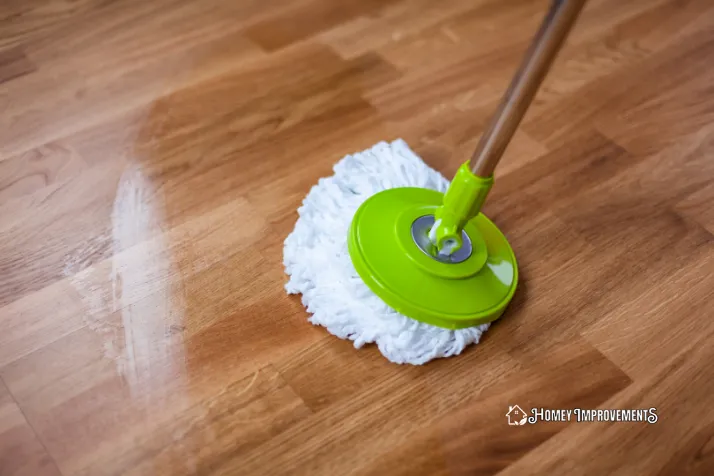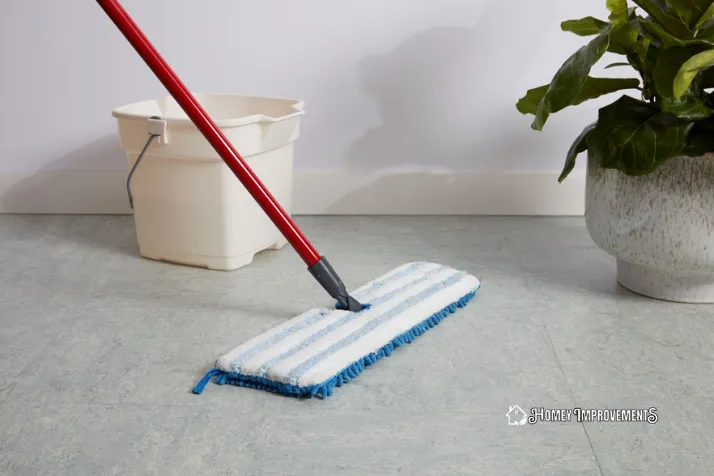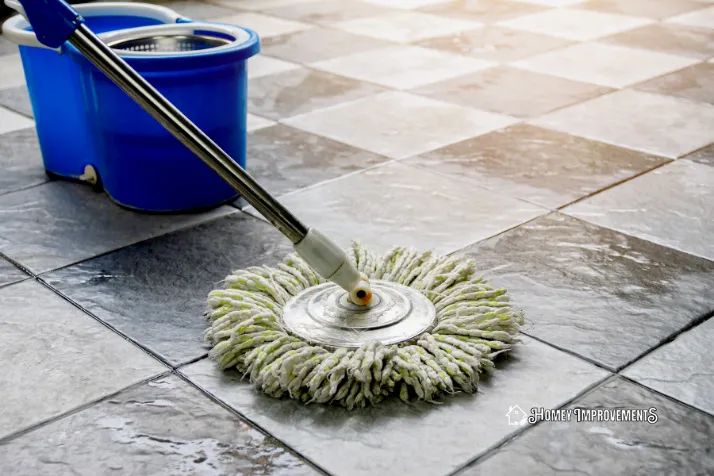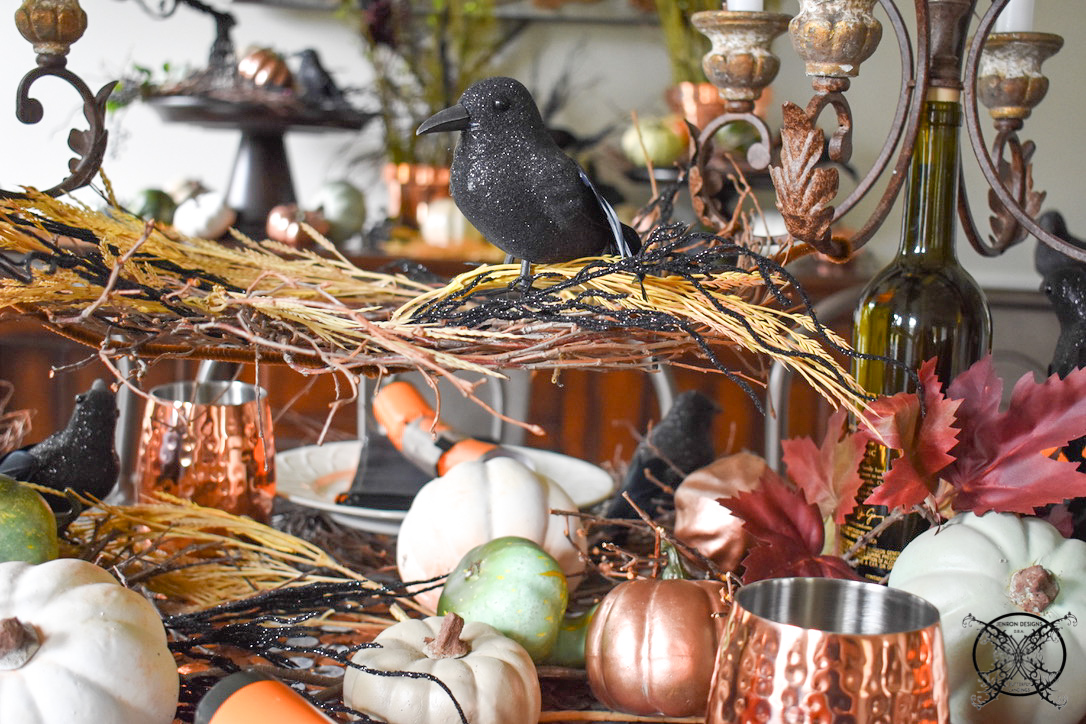Do you find your floor dirtier after mopping and looking for the right way to mop?
If you are getting a dirtier floor after cleaning it with a mop, you may not have swept the floor before mopping. It is important to sweep the floor first because you will get good results after removing your surface from dirt and debris.
Another important secret to getting a sparkling floor is to use a clean mop because a dirty mop will make the floor grimier. In this article, we will discuss the effective ways to mop a floor in the right way.
How to Mop the Floor?
- Prepare the floor for mopping by removing furniture and other things from it.
- Sweep the floor with a soft broom or vacuum.
- Wring the mop thoroughly to remove excess water as much as possible.
- Use two buckets for mopping; put cleaner in one bucket and clean water in the other.
- Start mopping from the corner of the floor, and don’t step into the clean area.
- Wash the mop with bleach and detergent to remove all the dirt.
- Let it air dry by hanging it in an open area.
Choosing the Right Cleaners
Most homeowners think that adding more soap to the mop solution will clean the floor. If you use too much soap in the solution, it will leave residues on the floor; as a result, the floor will become sticky.
Hence, a sticky layer on the floor surface will attract more dirt. Before using a cleaner, make sure it is safe for your floor.
Hardwood
If your hardwood floor has a wax or polyurethane finish, you must use pH-neutral or mild soap. Do not use homemade or store-bought cleaners with harsh chemicals because they will greatly damage the surface.
If your hardwood floor has a wax finish, use a slightly wet mop weekly; it should be almost dry. A wet mop will damage the wooden floor even if the spills are too small.
Laminate
The maintenance of laminate is like hardwood; even a small drop of water will seep into the planks of the floor and be ruined. Use a slightly damp mop and remove the spills immediately from this floor.
Commercial floor cleaners have harsh chemicals which can damage the surface, so avoid using them.
Vinyl
A vinegar and water solution is the best to mop the surface of these floors. As vinegar is an acidic solution, it cleans the surface without creating any residues and makes the floor germ-free.
Linoleum
Since the surface of linoleum is not as resilient as vinyl, it must not be cleaned with harsh cleaners. Make a solution of water and dishwashing soap in a spray bottle; apply it to the floor and use a clean mop over it.
Now, apply a slightly wet mop over the floor to remove the residues of dishwashing soap.
Stone Tile
Harsh chemicals can discolor stone tiles, so you should use a mild, pH-neutral cleaner that does not contain chemicals. Otherwise, the chemicals will react with the surface.
Vinegar, bleach, or ammonia should be avoided because a slightly harsh chemical can destroy the tiles.
Ceramic Tile
To clean ceramic tile, the best solution for a mop is vinegar. It cleans the surface effectively, eliminates the odor, and makes the floor germ-free. This solution is best if you have pets and kids at your home.
Steps to Mop a Floor?
1. Clear the Room
Before beginning the project, you must prepare the floor for mopping. It is necessary to remove the furniture and other things from the floor. You have to prepare the floor so that the mop can reach all the hard-to-reach places.
2. Sweeping the Floor
Most homeowners think that sweeping the floor before mopping is not necessary. But it is extremely important because the small particles, dust, and debris will make the surface dirtier.
The particles of dust or other messes may scratch some delicate surfaces like hardwood or stone floors.
3. Wring the Mop as Much as Possible
You must choose a mop according to the type of your surface. Most people think about a yacht or string mop when choosing it, but a sponge mop provides good results.
A string mop requires proper wringing because it holds excess water, but a sponge mop contains the minimum amount of water after wringing, so it is ideal for laminate and hardwood floors.
After picking the right mop according to your floor type, you dip your mop into the solution completely. Wait a few seconds to allow the mop to absorb the cleaner properly.
Now, take it out and wring it thoroughly so that all the excess water is removed as much as possible. Remember that your mop should be damp, not full of water.
For most floors like linoleum, hardwoods, and laminates, the mop should be wrung more than once to make it almost dry.
4. Use Two Buckets While Mopping
Using two buckets to get better results while mopping the floor is a good idea. Fill one bucket with your cleaner and the other with clean water.
So, dip your mop in the cleaner bucket first and wring it thoroughly, then dip it in the second bucket and remove water as much as possible.
When the water in the buckets gets too dirty, it is necessary to change the liquid because you will get dirt residues on the floor if you use it. Drain the dirty water in the toilet because it is full of germs and bacteria. Don’t drain it into the kitchen drain or any other floor drain.
5. Move the Mop in the Correct Way
The process of mop is the same as painting walls. Start mopping from the corner of the room, and don’t walk on the cleaned surface. You must follow a particular pattern while mopping a floor, especially on hardwood floors.
Hardwood floors have particular grains so you should mop in their direction. So, the mopping should be done according to the design of the surface.
If the floor has a stubborn stain, don’t stop mopping to remove the stain. Clean the stain with particular cleaners after mopping and wipe the floor with a clean cloth.
6. Cleaning Mop
Cleaning the mop is necessary because if you leave it in the bucket or hang it without washing it, it will be full of germs and dirt. So, the next day when you use it for mopping, it will make your floor dirtier, and the dirt particles will not get out even after washing it.
Hence, make a solution of bleach, detergent, and water and wash the mop in it for a few minutes to kill all the germs. Wring it 2 – 3 times to clean it thoroughly; now rinse it with clean water.
Repeat the rinsing process until the residues of bleach and detergent are removed completely. Hang it in the sunlight and let it dry completely.
Reasons for Dirty Floor After Mopping
Mop without Rinsing it
Most homeowners think that making the floor wet means the floor is clean. So, they take a mop, soak it in water, and wipe the floors with it. As a result, the floors don’t clean and become dirtier than before.
If the dirt particles are not cleaned from the mop thoroughly, and you use the same for your floor cleaning, the residues of the dirt are left on the surface.
When the Mop is Not Wrung Thoroughly
If the mop is not wrung completely and there is excess water, it makes the floor dull-looking because the spills marks are visible on it. A wet floor also attracts dust, so the surface becomes dirty again.
If the Floor is Not Swept
Sweeping is important before mopping because the floor may seem clean, but if you touch it with your finger, you will notice that it is full of dust and sand particles. If you use the mop on a dirty floor, it will not give you good results.
Too Much Soap Should be Avoided
Soap has an ingredient called surfactants; they pull out the dirt and oil and lift it into the water, so they float in it. Surfactants have two parts; a hydrophilic tail that attracts water and a hydrophilic head which repels water.
The surfactant’s head is stuck to the dirt and oil, and the tail pulls it into the water. If the soapy water has more dirt, the surfactants are filled with more dirt; hence, they are fully covered with dirt.
This is why when you drain dirty soapy water in the washbasin, it doesn’t stick to the basin; rather, it goes away. The water that you use for mopping will be covered with dirt. So, your mop pad will be saturated with soapy and dirty water.
Hence, the mop will not be able to clean the floor because it will have no option instead of leaving dirty residues. So, instead of cleaning the floor’s surface, it will start producing a dirty soapy residue that will make streaks on it.
FAQs – Frequently Asked Questions
How to Mop a Floor Properly?
To mop a floor properly, wring it as much as possible. Start it from a corner of the floor, and don’t step into the mopped area. After using the mop on one side, turn it over and start mopping. If the water in the buckets gets dirty, change it.
Which Thing is Best for Mopping Your Floor?
Dishwashing soap is best for mopping because it breaks grease and dirt, but it should not be used excessively; otherwise, the floor will look dull.
Does the Floor Need to be Rinsed After Mopping?
Don’t rinse the floor with too much water because it damages the floor’s color. Mopping is the best solution to keep the floors clean. However, remove water from the mop as much as possible to get better results.
Is Only Water Suitable for Mopping?
You can use plain water to clean the surface if the floor is not too dirty or oily. To disinfect or clean the floor thoroughly, you must add a slight cleaner.
Which Water is Best for Mopping, Hot or Cold?
Cold water is better than hot water while mopping the floor because it does not discolor the floor, especially some delicate surfaces like hardwood. It also gives a cool effect after cleaning the room.
Final Thoughts
Most homeowners don’t follow the exact rules of mopping, that’s why they don’t get good results after putting in their efforts. Sweeping is very important to eliminate the small dust and dirt particles before mopping.
Remove as much water from the mop as possible to make it almost dry, and add a little cleaner to its solution. Change the dirty water in the buckets frequently to avoid dirt residues on the surface.











